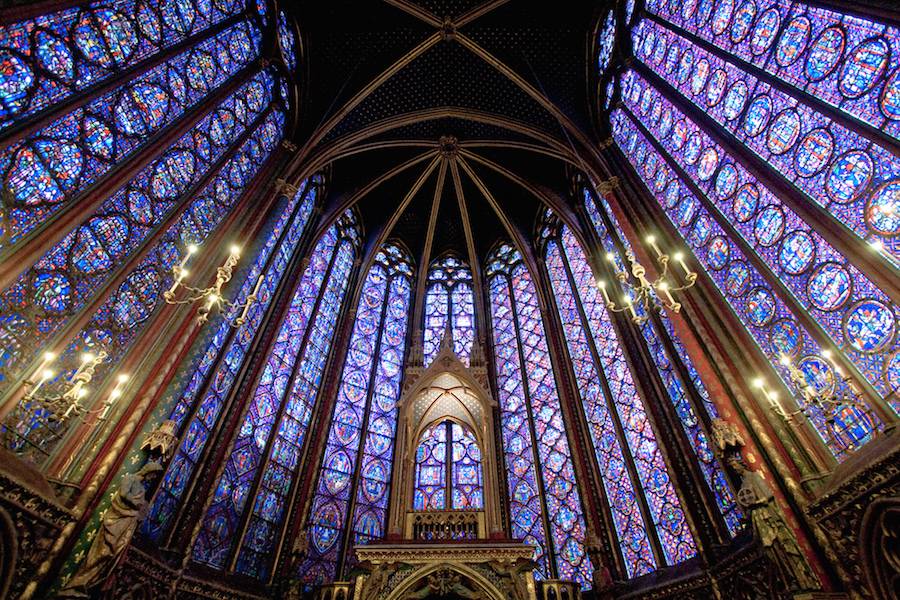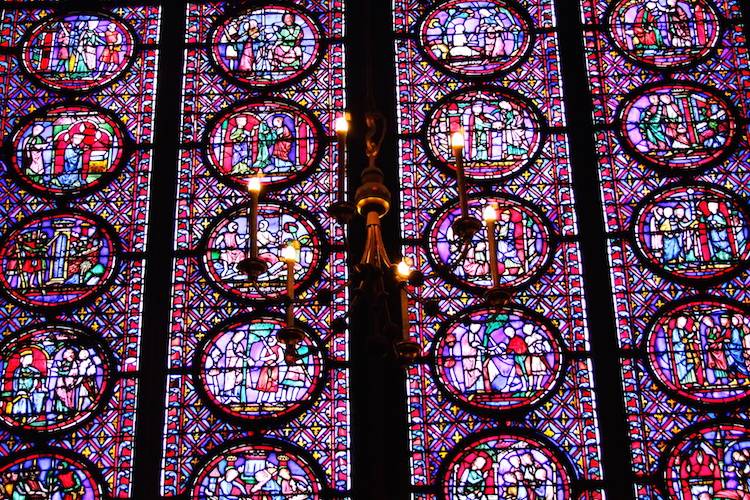One of my favourite sites of Paris, without a doubt is Sainte Chapelle. It could be the way that history, politics and religion are interwoven through the background. It could be the religious power of the chapel that came with housing the crown of thorns. It could even be the intricate detail of the external gothic architecture. But lets be honest, the real reason that we all yearn to visit is the Sainte Chapelle stained glass windows, which stunningly tell the story of the Bible.
The first time I ever saw Saint Chapelle, I was so overwhelmed by the beauty of it, that I didn’t take in the historical or religious significance. This week, I returned to Paris again for a second time, to be blown away by the beauty, but also to explore the background a little deeper.
Why was Sainte Chapelle built?
Located on Ile-de-la-cite, the island in the middle of the river Seine, the building complex (Palais de la Cite) in which Saint Chapelle is located was the heart of past Parisian politics and monarchy until the 14th Century. Sainte Chapelle was originally commissioned by King Louis IX of France to house the crown of thorns of Jesus Christ, seen to be one of the holiest relics in Christianity.
Despite being damaged in the French Revolution (1789-1799), Sainte Chapelle was restored in the 19th Century and remains one of the most stunning examples of stained glass in the world. The upper chapel itself was originally reserved for the King.

The Sainte Chapelle Stained Glass Windows
Only five colours are used in the Sainte Chapelle stained glass windows – blue (from cobalt), red and green (from copper), purple (from manganese) and yellow (from antimony). In the 13th Century, stained glass was cut with a red hot iron (it would be later cut by diamond).
Once cut, the pieces of coloured glass would be painted. Details such as facial expressions and folds in fabric were added with the ‘grisaille’ technique of monochrome painting in shades of grey. This is a mixture of powdered glass and iron oxide, diluted in water and vinegar and applied on to the coloured glass with a paint brush. The painted pieces of glass are then fired a second time at 600C to fix the grisaille.
When they had been coloured, cut and painted, the pieces of glass were then assembled scene by scene and held together with strips of channeled lead. Finished sections of the stained glass windows are never very large, to make sure that they don’t collapse under their own weight.
The stained glass windows are held together using iron bars and rods known as saddlebars. These support the whole window and hold it in place, taking the weight of the upper sections. The ‘vergettes’ are smaller, horizontal bars that strengthen the window from top to bottom.
Reading the Windows of the Sainte Chapelle Stained Glass
The Saint Chapelle stained glass windows themselves tell the story of the books of the Bible from Genesis on the left hand side, right round to the book of Revelation on the Rose window to the rear. Each stained glass window is made up of over 100 sections of stained glass.
The Sainte Chapelle stained glass windows are to be read from left to right and top to bottom. The widows numbered 1 to 15 start on the North wall, which is to your left when you enter the chapel. The iconography depicted by the windows is as follows:
- Genesis – the story of creation followed by the story of Adam and Eve.
- Exodus – the flight of the Israelites from Egypt, including the parting of the Red Sea.
- Numbers – the march out of Egypt and the coronation of the Kings of Israel.
- Deuteronomy/Joshua – the battle of the struggle against worship of idols, the naming of Joshua as the successor of Moses and the settlement of the Jews in the promised land.
- Judges – the story of Samson and Delilah.
- Isaiah – the first and longest of the prophetic books of the Bible in which the vision of the tree of Jesse prophesied the genealogy of Jesus Christ, Jesse’s son King David and the Virgin Mary.
- St John the Evangelist and the Childhood of Christ – St John, one of the closest observers of the life of Christ, which explains the presence of the window depicting Christ’s childhood.
- Christ’s Passion – One of the most important windows of Sainte Chapelle, just behind the raised altar. This window shows the last supper through to the Pentacost, with the crowning of thorns in the centre.
- John the Baptist/Daniel – John the Baptist was one of the last preachers to predict the coming of Christ, the lamb of God, and his sacrifice. The scenes featuring Daniel again focus on the struggle against idol worship.
- Ezekiel – Like Isaiah and Daniel, the book of Ezekiel also takes on the theme of idol worship, and this is followed by the destruction of Jerusalem.
- Jeremiah and Tobias – the visions of Jeremiah depict the fall of Jerusalem and the book of Tobias is an edifying story that was particularly important to St Louis.
- Judith/Job – Judith tells how this Jewish widow saved the town of Bethulia from the siege if the Assyrians by beheading their general. Job never wavers belief when tempted by Satan.
- Esther – Esther’s story is featured above the niche where Blanche of the castle, the queen mother used to sit, drawing parallels between the two heroines.
- Kings – Depicts the scenes from Kings I and II and Samuel I and II, which tell the story of the Kings of Israel, particularly Saul, David and Solomon.
- The Story of the relics of the passion – This window continues the theme to show St Louis as the legitimate successor to the Biblical rulers. It depicts the finding of the relics and the true cross in Jerusalem by St Helena, their journey to Byzantium, their purchase by St Louis and their final resting place in Sainte Chapelle.
- St John’s vision of the Apocalypse – This is depicted on the rose window facing West inline with the setting of the sun.
Facts about Saint Chapelle
- The upper chapel is 33m long and 10.5m wide.
- The vaulted ceiling rises to a height of 20.5m
- The stained glass windows date from 13th Century.
- Each window is 15.5m high in the nave and 13.5m in the apse.
- 1,113 scenes from the Bible are depicted on the windows.
- The rose window, 9m in diameter, dates from 15th Century.
How to get to Sainte Chapelle and where to stay
You can get to Sainte Chapelle by heading towards Ile-de-la-cite, the island in the middle of the river Seine. The nearest Metro stop is Cite.
Hotel Notre Dame and Hotel Victoria Chatalet are good value options if you want to stay close to this location. If you are looking for something a little cheaper, check out Pigalle district near Monmartre. You can also compare accommodation prices on Trip Advisor, Agoda or booking.com.

